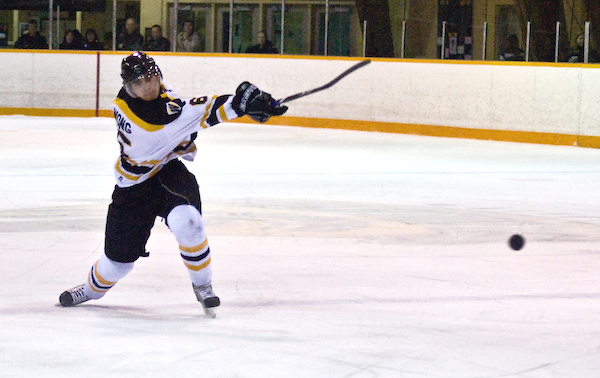Dear Sports Fan,
How does a slap shot work in ice hockey? Can you describe how it works and when or why a player would choose to use it?
Thanks,
Marie
Dear Marie,
There are three main kinds of shots in ice hockey: the slap shot, the snap shot, and the wrist shot. Each shot has its own technique and is distinguishable when watching hockey on TV or in person. Each shot has advantages and disadvantages and is appropriate for different situations. In this post, we’ll describe hockey’s most iconic shot, the slap shot. You’ll learn how to identify it when you see it, when and what it’s used for, and even how to do it if you find yourself with a hockey stick in your hands.
The slap shot is perhaps the most iconic image people have of a hockey shot. A player winds up for it, bringing their stick up almost vertically behind them before using all their muscles to swing it down. Instead of hitting the puck directly, as you might expect, in a slap shot, the stick makes contact with the ice a few inches behind the puck. When this happens, the stick actually bends with the blade of the stick forced backwards by the impenetrability of the ice. As the stick’s forward motion continues, the blade releases from the ice, getting an extra bit of speed by springing forward just as it connects with the puck. The result is a powerful shot, the most powerful in hockey. As you can see in this .gif from a “hardest shot competition” in last year’s NHL All Star game, slap shots can travel over 100 miles per hour!
The clearest advantage of a slap shot is speed. Ironically, the disadvantage is also speed. Although the slap shot propels the puck faster than any other shot, it also takes the longest time to execute. In today’s NHL, it’s rare for a player to have enough time to wind up and release a slap shot before a defender has hit them, stolen the puck from them, or slid into a position to block the shot. Even if a player does have time to get a slap shot off, they aren’t particularly deceptive. If a goalie has time to set up in position to save a slap shot, they’ll probably be able to do so. The times when a slap shot are most effective are when a player can execute the process before the defense knows they’re going to be in a position to shoot. This usually means one of the shooter’s teammates has the puck and passes it to the shooter as he’s setting up to shoot. This type of slap shot, directly from a pass, is called a one-timer. It has an added element of difficulty because the shooter must time and position their shot to strike a moving puck but when it works it’s almost unstoppable.
If you want to work on taking a slap shot yourself, your best bet is to start on solid ground. With shoes on pavement, a slap shot is no harder than swinging a golf club. It’s on ice that things get tricky. You must be able to swing your stick and torque your body with great force without losing your balance. Practice it incrementally, starting with a small windup and working up to a full one. You’ll know you’ve gone too fast when you find yourself sitting on the ice without having moved the puck at all. Another note for beginners — unless you’re freakishly strong, don’t try to do the trick the pros do to get extra speed by hitting the ice first. You’re probably not stronger than your stick, so instead of it bending, your body will take the brunt of the ice’s impact. Ouch!
Thanks for reading,
Ezra Fischer

